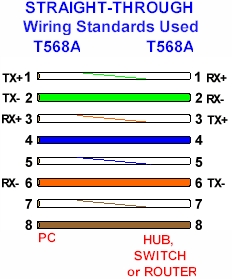
These are the pin-out diagrams for straight through and crossover UTP Ethernet cables.

The TX (transmitter) pins are connected
to corresponding RX (receiver) pins, with plus to plus and minus to minus.
A coss-over cable must be used to connect units with identical
interfaces.
When straight-through cables are used to connect
Ethernet devices, one of the two units must, in effect, perform the cross-over
function. This is the reason that straight through cables work directly
between hubs or switches and NIC cards.... the Hub or Switch is designed so that
their RJ45 Jacks are pre-wired with the transmit and receive pairs already
reversed.
There are two color-code standards in common use: EIA/TIA 568A and EIA/TIA 568B. These standards derive from TELCO usage and the pairs shown correspond to four phone lines, each with its own line pair. This same wiring was adopted for LAN standard Ethernet RJ45 wiring as well. RJ45 receptacle wiring for both standards are shown below:
|
|
Note: Only pairs 2 and 3 are used for Standard Ethernet wiring. Pairs 1 and 4 can be used for other purposes such as telephones or even a second separate, complete Ethernet connection.
Straight-Through Wiring Using The 586A Standard

The flat wiring diagram, above, shows the 568A color code standard as the wiring for the PC side of the cable and the same 568A standard for the Hub, Switch or Router side of things (assuming that the Hubs, Switches or Routers are wired internally to perform the cross-over function). The illustration depicts the wiring arrangement before insertion into an RJ45 connector prior to crimping.
Cross-Over Wiring Using The 568A to 586B Standards

The flat wiring illustration, above, shows cross-over cable wiring using the 568A color code standard as the wiring for the PC side of things and the 568B standard for wiring to the other PC. Note that in both cases, all eight wires are shown but only four are actually needed.
Pins 4, 5, 7, and 8 and the blue and brown pairs are not used in either standard. Contrary to common tech-lore and what you may have read elsewhere, these pins and wires are not used or required to implement 100BASE-TX duplexing. In fact, they can be used for other purposes such as a single line phones or even operating two separate Ethernet channels, provided care is taken to assure that these wire pairs are isolated from the other wires.
In practice, making actual RJ45 Patch cables is not physically that simple. The connections of the pairs to the pins in the RJ45 jack isn't wire pair by wire pair. Instead, the orange pair of wires are not adjacent and the blue pair is upside-down. If fact, flattening out the cables in the correct order for insertion into the RJ45 jack before crimping is by far the most complex part of the job of making twisted pair Ethernet patch cables.
One cannot use flat-untwisted telephone cable for a network cable that runs any appreciable distance. One must use a pair of twisted wires to connect a set of transmitter pins to their corresponding receiver pins. One cannot use a wire from one pair and another wire from a different pair...